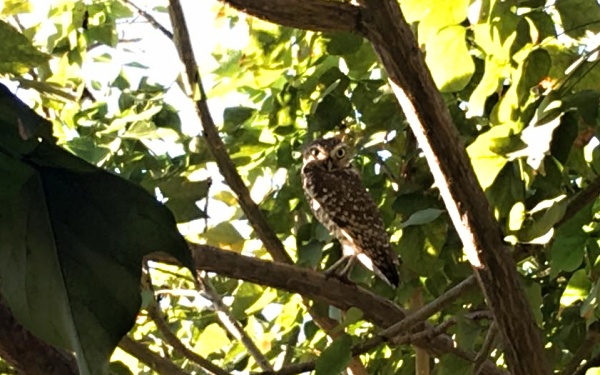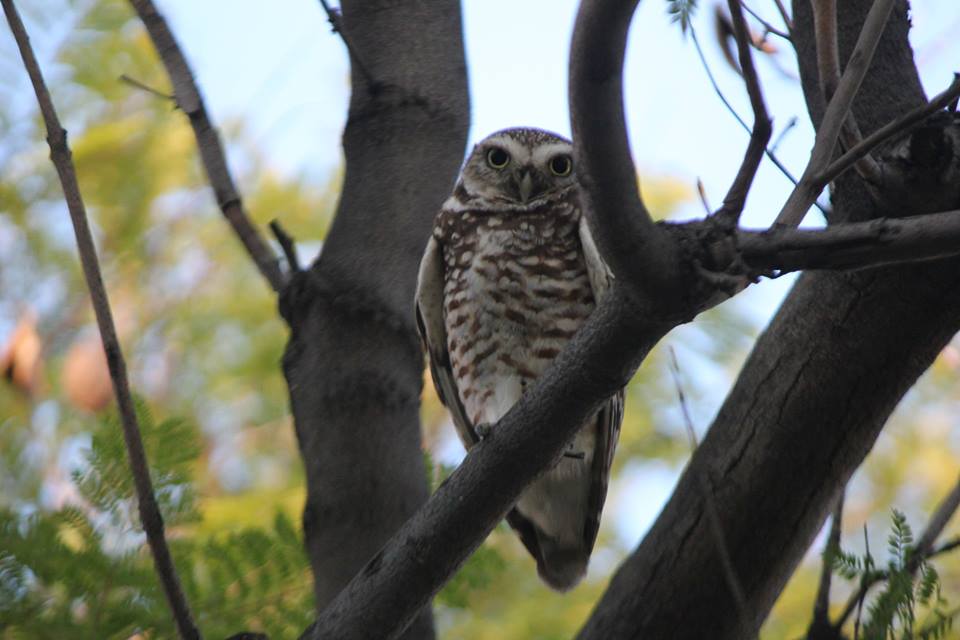Esperanza Elementary School is welcoming a surprisingly new visitor to the urban downtown campus, a winged wonder that both students and faculty hope will stick around a little longer.
A burrowing owl, more commonly found in the grasslands and deserts, has been seen regularly at the inner-city school (located just blocks from MacArthur Park) which just recently restored green spaces around its campus and nearby Wilshire Boulevard.
Esperanza’s owl was first discovered on Tuesday, Nov. 30, and has been hanging around ever since, says Brad Rumble, principal of the PK-5th grade school that serves 800 students. “It was a fourth grader Nathan, a true birder, who saw it first,” says Rumble explaining that the long-legged, yellow-eyed predator was discovered among the branches of a courtyard coral tree.

The tree’s location – near a second story breezeway – offers prime viewing of critters that inhabit the mature tree. Students often see nesting mourning doves as well as yellow-rumped warblers. Under Rumble’s direction, the school has been integrating the Los Angeles natural world into both the physical campus as well as the school curriculum.
Finding a burrowing owl in a tree – in a busy urban area – is indeed a little out of the norm, but not unheard of says biologist Dan Cooper.
“The species is highly migratory, often seen flying over open ocean on boat trips to the Channel Islands, and turning up in odd places, particularly during fall migration,” explains Cooper. “Wintering birds may appear in areas where resident/breeding populations are no longer present, including the Ballona Wetlands, Oxnard Plain, and Bolsa Chica – anywhere there is flat land and a ground-squirrel population, since they need burrows for wintering as well as breeding. Wintering birds have even been seen using vents and other crevices in parking structures in the middle of the city where they probably subsist on mice and rats.”
Burrowing owls are species in sharp decline because of habitat loss; at one time the Los Angeles Basin was a prime habitat for the long-legged, yellow-eyed predators. One of the smallest owls around (they weight about 3.5 ounces), they typically take over existing ones from tortoises, ground squirrels or prairie dogs and feast on rodents as well as insects. According to biologist Dan Cooper: “Today the only nesting pairs in Southern California away from the desert are a handful on Otay Mesa east of San Diego, in remaining agricultural lands near Chino, and in the San Jacinto Valley near Hemet. Birds apparently nested at the Seal Beach Naval Weapons Station until around 2013.”

In early November, the school re-wilded 5,000 sq. ft. of its campus, peeling up asphalt and, with the help of LA Audubon, planting natives. Nearby on Wilshire Boulevard, almost 4,000 sq. ft. was also recently restored with natives and other nature-attracting greenery courtesy of Rancho Santa Ana Botanic Gardens.
For Rumble, the rare owl opportunity has presented the students with a chance to witness nature up-close. “Most of these kids live in apartments and it’s wonderful for them to see nature on the campus and learn about what it means to be a good steward of the land. We have seven kindergarten classes that line up in the mornings right under the tree it’s in. We have a citizen science bulletin board and kids add their observations to it daily.”
There is even talk to change the official mascot of the school from the Esperanza Dragons to the Owls. Just as fierce? You bet.
On weekends, the school campus has open playground time for kids and families; this Saturday, that playtime turned into an impromptu birding session that included watching the warblers, hummingbirds and, of course, owl.

Esperanza’s owl was last seen investigating the new native habitat which thrills Rumble and the student body. There is talk of erecting an artificial burrow on campus to help the owl through the winter. The nearby jacaranda tree, where the owl is now perching, may offer enough insects for the bird to survive in the coming months.
Rumble says that if the kids didn’t pay attention to their surroundings they may have missed this aerial visitor. “The whole thing reminds me of the saying from the movie American Beauty to always ‘Look closer.’ You really never know what you will find in Los Angeles. Don’t forget to look up and look really close.”
— Story by Brenda Rees; photos by Brad Rumble
